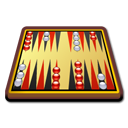Backgammon/Glossary

A
edit- Acey-deucey (or Acey-deucy)
- A variant of backgammon in which the roll of 1 and 2 gives the player extra turns.
- Anchor
- A point occupied in the home board by two or more of opponent's checkers.
B
edit- Backgammon
- A game in which one player bears off all of his checkers while his opponent still has one or more checkers on the bar or in the winner's home board, counting for triple a normal game.
- Bar
- The area where blots are placed after being hit, usually, a raised divider between the home boards and outer boards.
- Bar point
- Either of the two points in the outer board adjacent to the bar; the 7-point or the 18-point.
- Bear off
- To remove a checker from the home board by rolling a number that equals or exceeds the point on which the checker resides.
- Block
- A point occupied by two or more checkers on the home board or the outer board.
- Blot
- A single checker vulnerable to being hit.
C
edit- Checker
- One of the 15 playing pieces allotted to each player.
- Cubeless Equity
- The value of a position ignoring the use of the doubling cube. This is a value between -3 and +3 that takes into account the probabilities of either side winning a single game, winning a double game or winning a triple game. If at a given point in the game neither party can make a gammon, the cubeless equity of a player simply is the probability of him/her winning the game, minus the probability of the opponent winning the game.
D
edit- Deep Anchor
- An anchor on the opponent's one-point or two-point.
- Doubles
- A dice roll in which both values are identical, e.g. 1-1 or 6-6.
E
edit- End Game
- The phase of a game which starts when one of the players begins to bear off.
F
edit- Full prime
- A prime of six consecutive points that completely blocks the opponent from moving checkers in front of the prime to behind the prime.
G
edit- Gammon
- A game in which one player removes all his checkers before his opponent can remove any, and counted as a double win.
H
editI
edit- Inner board
- Home board.
M
edit- Match
- A series of games of backgammon, played until one participant reaches a predetermined score.
- Mid point
- Either of the two points furthest from the bar; the 12-point or the 13-point.
N
edit- Normalized Match Score
- A match score expressed in terms of the number of points needed by both sides to win the match. For instance, '2-away/4-away' (or: -2/-4) could indicate the state of seven-point match in which one party has gained five points and the other side three points.
- Notation
- In backgammon the common way of describing the movement of checkers involves numbering the points around the board from 24 to 1 such that the numbers diminish when the checkers move towards the home board. This implies that a reverse numbering applies when the opponent is on roll (with the 24-point now referred to as the 1-point, etc.). A move of a single checker is indicated by the start and the end number separated by a slash. If a move results in a checker being hit, this is indicated by adding an asterisk to the number on which a checker was hit.
O
edit- Open point
- A point a player can in principle move his checkers to. I.e. a point that is not occupied by more than one opposing checker.
P
edit- Pip
- One of the markings on the face of a die, corresponding to a movement of one point.
- Point
- One of the twenty-four narrow triangles on the backgammon board where the players' checkers sit, or the value of a single game of backgammon before accounting for the doubling cube, or a gammon or backgammon.
- Prime
- Several consecutive points held by a player.